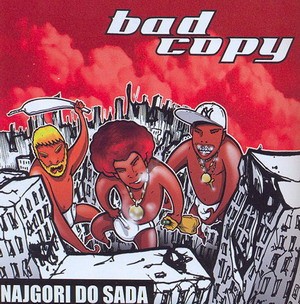The air interface, or access mode, is the communication link between the two stations in mobile or wireless communication. The air interface involves both the physical and data link layers of the OSI model for a connection.
Visual design elements and principles may refer to:
The Open Document Management API is an API that simplifies the communication of desktop applications with document management systems (DMS). ODMA standardizes the access to the DMS, which makes getting to these files as easy as if the files were in the actual local file system.
ND-NOTIS was a office automation suite by Norsk Data introduced in the early 80s, running on the SINTRAN III platform on both ND-100 and ND-500 architectures. It was also available on Microsoft Windows running in networks of Norsk Data servers.
Feature article may refer to:

Rhett James McLaughlin and Charles Lincoln "Link" Neal III are an American comedy duo. Self-styled as "Internetainers", they are known for creating and hosting the YouTube series Good Mythical Morning. Their other notable projects include comedic songs and sketches, their IFC series Rhett & Link: Commercial Kings, their YouTube Premium series Rhett & Link's Buddy System, their podcast Ear Biscuits, their YouTube series Wonderhole, and their novel The Lost Causes of Bleak Creek.

Opportunity-Driven Multiple Access (ODMA) is a UMTS communications relaying protocol standard first introduced by the European Telecommunication Standards Institute (ETSI) in 1996. ODMA has been adopted by the 3rd-Generation Partnership Project, 3GPP to improve the efficiency of UMTS networks using the TDD mode. One of the objectives of ODMA is to enhance the capacity and the coverage of radio transmissions towards the boundaries of the cell. While mobile stations under the cell coverage area can communicate directly with the base station, mobile stations outside the cell boundary can still access the network and communicating with the base station via multihop transmission. Mobile stations with high data rate inside the cell are used as multihop relays.

Najgori do sada is the third album from Serbian hip-hop band Bad Copy. The album was released in December 2006. Videos were shot for two songs Bad Copy Žoor and Idemo Odma ft. Škabo both produced by Đolođolo.
LGBTQ literature may refer to:

Rock @ Roll is the seventh album by the Croatian rock band Aerodrom, released through Croatia Records in 2007. The album marked the band's 30th anniversary, which they celebrated at a New Year's Eve concert in Ban Jelačić Square in Zagreb. Jurica Pađen wrote all of the music and lyrics, except for "Fait Accompli", a song co-written with Branimir Štulić and dedicated to John Lennon. Rock @ Roll was recorded as a trio with new drummer Slavko Pintarić 'Pišta'. The album included four new singles, "Mili moj anđele", "Tvoj pas me čudno gleda", "Kći starog vodeničara" and "Odma mi je zapela za oko".
Cambridge Movement may refer to:
The molecular formula C10H13N3O may refer to:
Talks at Google is a global, internal talks series hosted by Google. The talks are most often hosted for Google employees before being publicly released on their YouTube channel.

Google Family Link is a family parental controls service by Google that allows parents to adjust parameters for their children's devices. The application allows parents to restrict content, approve or disapprove apps, set screen times, and more. Google Family Link requires Google accounts in order to access the app remotely.
Northeastern Ukraine campaign may refer to:

The Oxford Dictionary of the Middle Ages (ODMA) is a four-volume dictionary of the Middle Ages published by Oxford University Press. It contains over 5,000 entries concerning European history and culture from AD 500 to 1500 as well as topics related to the Byzantine Empire, Islamic history, and medieval Asia. Subjects covered in the dictionary include art, architecture, medicine, law, archaeology, ecclesiastical history, languages, and literature of the medieval world. The work is preceded by The Oxford Dictionary of Late Antiquity, which covers the years AD 250 to 750.

ODMA is a bioisosteric analogue of 3,4-methylenedioxy-N-methylamphetamine (MDMA) which was developed in an attempt to create an improved MDMA alternative for potential clinical use. It is the analogue of MDMA in which the 1,3-benzodioxole ring has been replaced with a 2,1,3-benzoxadiazole ring. TDMA and SeDMA are closely related analogues. ODMA, TDMA, and SeDMA are releasing agents of serotonin, norepinephrine, and dopamine similarly to MDMA. However, they are less potent and efficacious in activating the serotonin 5-HT2A, 5-HT2B, and 5-HT2C receptors than MDMA and show differing and potentially improved metabolic and pharmacokinetic properties in comparison. ODMA, TDMA, and SeDMA were first described in the scientific literature in June 2024.

TDMA is a bioisosteric analogue of 3,4-methylenedioxy-N-methylamphetamine (MDMA) which was developed in an attempt to create an improved MDMA alternative for potential clinical use. It is the analogue of MDMA in which the 1,3-benzodioxole ring has been replaced with a 2,1,3-benzothiadiazole ring. ODMA and SeDMA are closely related analogues. ODMA, TDMA, and SeDMA are releasing agents of serotonin, norepinephrine, and dopamine similarly to MDMA. However, they are less potent and efficacious in activating the serotonin 5-HT2A, 5-HT2B, and 5-HT2C receptors than MDMA and show differing and potentially improved metabolic and pharmacokinetic properties in comparison. ODMA, TDMA, and SeDMA were first described in the scientific literature in June 2024.

SeDMA is a bioisosteric analogue of 3,4-methylenedioxy-N-methylamphetamine (MDMA) which was developed in an attempt to create an improved MDMA alternative for potential clinical use. It is the analogue of MDMA in which the 1,3-benzodioxole ring has been replaced with a 2,1,3-benzoselenadiazole ring. ODMA and TDMA are closely related analogues. ODMA, TDMA, and SeDMA are releasing agents of serotonin, norepinephrine, and dopamine similarly to MDMA. However, they are less potent and efficacious in activating the serotonin 5-HT2A, 5-HT2B, and 5-HT2C receptors than MDMA and show differing and potentially improved metabolic and pharmacokinetic properties in comparison. ODMA, TDMA, and SeDMA were first described in the scientific literature in June 2024.








